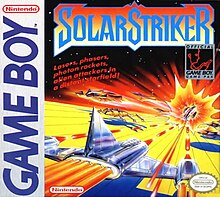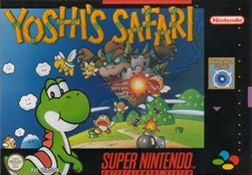
Yoshi's Safari is a 1993 light gun shooter developed and published by Nintendo for its Super Nintendo Entertainment System (SNES). It is the only Mario franchise game to feature first-person shooter gameplay and requires the SNES's Super Scope light gun. As Mario and his pet dinosaur Yoshi, the player embarks on a quest to save the kingdom of Jewelry Land from Bowser and his Koopalings, who have kidnapped its rulers and stolen 12 gems. The game features 12 levels in which the player shoots enemies like Goombas and Koopas, and collects power-ups and coins. At the end of each level, the player engages in a boss fight with an enemy, a Koopaling, or Bowser. Nintendo commissioned its R&D1 department to develop Yoshi's Safari in response to the waning popularity of the Super Scope. Yoshi's Safari was the first Super Scope title to use the SNES's Mode 7 graphics mode, and the future of the peripheral depended on the game's performance.

Steel Empire is a horizontally scrolling shooter released on the Sega Genesis in 1992. Versions for the Game Boy Advance and Nintendo 3DS were released in 2004 and 2014, respectively. The game is scheduled for release on the Nintendo Switch in 2023.

Wizards & Warriors, titled Densetsu no Kishi Elrond in Japan, is an action platform video game developed by Rare and published by Acclaim Entertainment for the Nintendo Entertainment System. It was released in North America in December 1987, and in Europe on January 7, 1990. The player controls Kuros, "Knight Warrior of the Books of Excalibur", as he sets out in the Kingdom of Elrond to defeat the evil wizard Malkil. Malkil holds the princess of Elrond captive in Castle IronSpire, deep within the forests of Elrond. The player fights through forests, tunnels, and caves, while collecting keys, treasure, weapons, and magic items.

Abadox: The Deadly Inner War is a video game for the Nintendo Entertainment System published in Japan in 1989 by Natsume and North America in 1990 by the Milton Bradley Company. It is a horizontally scrolling shooter in the vein of Gradius and R-Type taking place inside the intestinal tract of a giant alien organism. Abadox has a high difficulty, and it takes one hit from an enemy projectile to be killed and restart from a checkpoint passed before death.

To the Earth is a light gun shooter video game developed by Cirque Verte and published by Nintendo for the Nintendo Entertainment System. It was released in November 1989 in North America and in Europe on February 23, 1990. It uses the NES Zapper to destroy ships and gain power-ups. The enemy spacecraft require good reflexes and aiming.
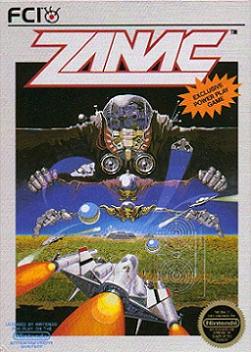
Zanac (ザナック) is a shoot 'em up video game developed by Compile and published in Japan by Pony Canyon and in North America by FCI. It was released for the MSX computer, the Family Computer Disk System, the Nintendo Entertainment System, and for the Virtual Console. It was reworked for the MSX2 computer as Zanac EX and for the PlayStation as Zanac X Zanac. Players fly a lone starfighter, dubbed the AFX-6502 Zanac, through twelve levels; their goal is to destroy the System—a part-organic, part-mechanical entity bent on destroying mankind.
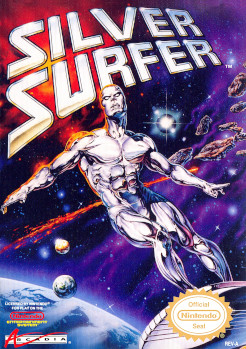
Silver Surfer is a 1990 scrolling shoot 'em up video game developed by Software Creations and published by Arcadia Systems. The game was released in November 1990 in the United States exclusively for the Nintendo Entertainment System. Silver Surfer is based on the Marvel Comics character Silver Surfer, and is primarily known for its high difficulty and highly praised music.

Adventure Island 3 is a side-scrolling platform game published by Hudson Soft that was originally released for the Nintendo Entertainment System in 1992. It is the third game in the Adventure Island released for the NES, following Adventure Island II. Unlike the first two games in the series, the NES version was never released in Europe. A portable version was also released for the Game Boy in 1993 titled Takahashi Meijin no Bouken Jima III, renamed to Adventure Island II: Aliens in Paradise outside of Japan.

Legendary Wings is a fantasy-themed shoot-'em-up / platformer arcade video game released by Capcom in 1986. The player takes control of a young soldier equipped with magical wings who must save the world from a malfunctioning supercomputer. A home version for the Nintendo Entertainment System was released exclusively in North America in 1988. The original coin-op version is included in Capcom Classics Collection for PlayStation 2 and Xbox and in Capcom Classics Collection Remixed for PlayStation Portable.

Earth Defense Force is a 1991 horizontal scrolling shooter video game developed and published by Jaleco. Originally an arcade game, the game was later released for the Super Nintendo Entertainment System as Super Earth Defense Force, dropping the two-player cooperative gaming mode while adding graphics and selectable weapons. The SNES version was released in Japan on October 25, 1991, and in North America in January 1992. The SNES version was eventually released on the Wii Virtual Console in Europe on October 29, 2010, and in 2011 for Japan on January 11, and North America on July 14. It is included in Nintendo Switch SNES Online as of September 2019.
Gradius is a series of shooter video games, introduced in 1985, developed and published by Konami for a variety of portable, console and arcade platforms. In many games in the series, the player controls a ship known as the Vic Viper.
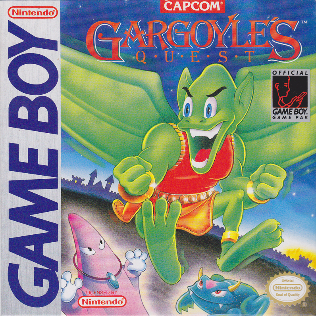
Gargoyle's Quest is an action-adventure platform game developed by Capcom for the Game Boy and released in 1990. It is a spin-off of the Ghosts 'n Goblins series, featuring the series antagonist character Firebrand as the main playable character. Gargoyle's Quest was followed by the NES prequel Gargoyle's Quest II in 1992 and the Super NES sequel Demon's Crest in 1994.
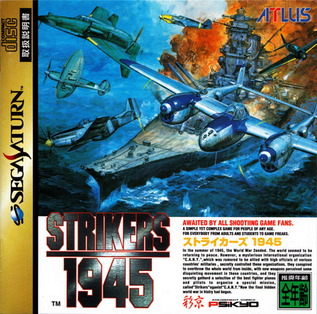
Strikers 1945 (ストライカーズ1945), also known as Striker 1945, is a vertically scrolling shoot 'em up arcade game developed and published by Psikyo in 1995. In Japan, it was ported to the PlayStation and Sega Saturn by Atlus in 1996; later was also released as part of Psikyo Shooting Collection Vol. 1: Strikers 1945 I & II by Taito for the PlayStation 2. The game was followed by Strikers 1945 II in 1997, and Strikers 1945 III in 1999, as well as the second title remake called Strikers 1945 Plus.

Thunder Force IV, known in North America as Lightening Force: Quest for the Darkstar, is a shoot 'em up video game developed and published by Technosoft for the Mega Drive in 1992. It is the fourth installment in Technosoft's Thunder Force series, and the third and final one created for the Mega Drive. It was developed by the team at Technosoft that ported Devil's Crush to the Mega Drive rather than the team that developed the previous Thunder Force games. Like its predecessors, it is a horizontally scrolling shooter, but it also features extensive vertical scrolling with large playing fields.
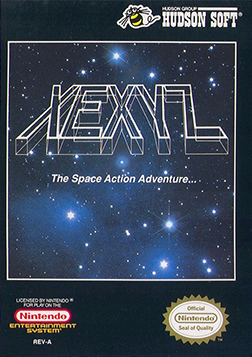
Xexyz, known in Japan as Kame no Ongaeshi - Urashima Densetsu, is a 1988 video game published by Hudson Soft for the Nintendo Entertainment System. The game was released in Japan on August 26, 1988, and saw a North American release sometime in April 1990. The game was never released in Europe and the game is not playable on PAL consoles.

Gunhed, known as Blazing Lazers in North America, is a vertically scrolling shooter game by Hudson Soft and Compile, based on the Japanese film Gunhed. The title was released in 1989, for the PC Engine in Japan and re-skinned for the TurboGrafx-16 in North America, with Gunhed unofficially imported for the PC Engine in Europe. In the game, a fictional galaxy is under attack by an enemy space armada called the Dark Squadron, and this galaxy's only chance for survival is the Gunhed Advanced Star Fighter, who must destroy the Dark Squadron and its Super Weapons. The gameplay features fast vertical scrolling and a wide array of weapons for the player to use.

Somer Assault, known as Mesopotamia in Japan, is a video game developed and published by Atlus in 1991 for the TurboGrafx-16. This side-scrolling action game features an unnamed pink Slinky object/creature as the protagonist which can fire bullets from its sides, jump, and slink along walls in its quest to stop an evil sorceress. The title is a play on the word somersault, as the Slinky somersaults around the stage while assaulting enemies.

Burai Fighter is a shoot 'em up video game developed by KID for the Nintendo Entertainment System. The game was released in North America by Taxan in March 1990, PAL regions by Nintendo in 1990, and Japan by Taito on July 20, 1990. The game was ported to the Game Boy and retitled as Burai Fighter Deluxe, and was released in Japan on June 27, 1990, in North America in January 1991 and in Europe in 1991; this port was released for the Game Boy Color as Space Marauder, originally released in Japan as Burai Fighter Color, as the original Game Boy version is not compatible with the later models.

Darius Force, known as Super Nova in North America, is a horizontal scrolling shooter for the Super Famicom/SNES, released in 1993 and is part of the Darius series.

Chikyū Kaihō Gun ZAS is a vertical scrolling shooter video game developed and published by T&E Soft for the Nintendo Game Boy exclusively in Japan on December 18, 1992.
